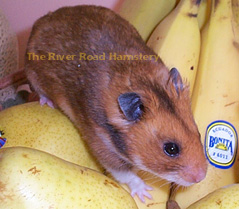
Contents
Genetics Index
The Basics
Chromosomes and
Genes
Dominant and Recessive,
Genotype and
Phenotype
Homozygous and
Heterozygous
Sex Chromosomes and
Sex Linkage
X-Inactivation
Mutation
Mutation Basics
Mutation in Syrians
Table of Mutations
Inheritance
Gametes
Punnett Square
Monohybrid Cross
Dihybrid Cross
Trihybrid Cross
Linkage
Sex Linkage
A Common
Misconception
Probability
The Nuts and Bolts
Examples
Principles of Breeding
Breeding Techniques
Dominant Traits
Recessive Traits
Epistasis
Lethality
Inadvisable Crosses
Lineal Purity v.
Heterogeneiry
Tortoiseshells and
Tricolors
Genotyping
Agouti v. Self
Basic Colors
The Golden Genotype
Combination Colors
Coat Types
Patterns
Eye Color
Ear Color
The Preliminary Genotype
Expanding the Genotype
• Parents
• Siblings
• Offspring
River Road Hamstery
(limited version)
Contact
|
Syrian Hamster Genetics: Mutation Every time a cell divides each chromosome is replicated (copied exactly) so that the daughter cells will have the same chromosomal complement as the original. Rarely, a mistake is made during replication that alters (mutates) a gene, producing a new allelic form. Radiation and certain chemicals can also induce mutations. Once a mutation occurs it is permanent and will be copied faithfully with cell division. Mutations in germ cells (cells that become eggs and sperm) can be passed on to future generations. Most mutations are harmful. Embryos from mutated germ cells are often incapable of survival. A seemingly innocuous mutation like a change in fur color may make an animal in the wild much more visible to predators. Its genes would not be passed on, and the mutated gene would become extinct. This keeps the animals of a species looking very similar, and this look is called the wild type. The color and markings of a wild type are also referred to as agouti.
Once animals are captured and bred in captivity, mutations are watched for, and if they cause what is felt to be a desirable change, they are selected for. In this way, over time, many different phenotypes can be developed. Syrian hamsters have 44 chromosomes - 21 pairs of autosomes and 2 sex chromosomes. On these chromosomes are tens of thousands of genes, all governing the hamster's appearance and functioning. Of these, only about two dozen have been identified that affect color, coat type and pattern. Several are restricted to laboratory populations, leaving 21 that are seen in pet and show stock. Some are very common; others may be extinct or nearly so. Each of these genes has become identifiable only because a mutation has occurred at the locus. The following table lists the mutations along with the possible genotypes for each locus. In a wild population, genotypes would hardly ever include mutant genes. (For example, at the E locus, an agouti hamster would nearly always be EE, not Ee which would have required either a mutation or inheritance from a parent with e.) In human-owned stock, agouti hamsters often carry hidden recessive mutant genes.
2 Rudimentary or absent eyes and a shortened lifespan of 6 to 12 months. 3 White Bellied pattern in Agoutis and Blacks, Roan pattern in Cream-based colors. 4 "Doubly satinized" with thin, unattractive fur so breeding for this type is discouraged. 5 Heterozygous Silver Grey is similar to Light Grey in appearance. 6 Y indicates the male genotype - only one allele is present because there is only a single X chromosome. A few things to note: All wild type counterparts to the recessive mutations are considered to be completely dominant. That is, there is no reliable difference in phenotype between AA and Aa, EE and Ee, etc. It is appreciated by show breeders, however, that heterozygosity can produce subtle changes in color and coat. The recessive mutation at the C locus in some other species is c (without any superscript). Only the cc genotype results in true albinism. The related mutations seen in Syrians (written with the d or e superscripts to designate them as different alleles from c) allow partial pigmentation. Since these hamsters are not totally devoid of pigment, they are not true albinos. For full descriptions and photos of the colors, patterns and coat types, please refer to the Pet Web Site. |
|||||||||||||||||||||||||||||||||||||||||||||||||||||||||||||||||||||||||||||||||||||||||||||||||||||||||||||||||||||||||||||||||||||

No part of this website may be reproduced in any form or by any means
without the prior written consent of the owner.
 The Agouti phenotype in the Syrian hamster is the common shorthair Golden. It has a golden brown coat with a dark slate
grey undercolor. The coat is ticked through with black guard hairs. There is a golden brown chest band and black cheekflashes in front of ivory crescents. The belly is also ivory.
Eyes are black. Ears are dark grey. The Golden hamster has an agouti phenotype at every locus governing color, coat type and pattern.
The Agouti phenotype in the Syrian hamster is the common shorthair Golden. It has a golden brown coat with a dark slate
grey undercolor. The coat is ticked through with black guard hairs. There is a golden brown chest band and black cheekflashes in front of ivory crescents. The belly is also ivory.
Eyes are black. Ears are dark grey. The Golden hamster has an agouti phenotype at every locus governing color, coat type and pattern.